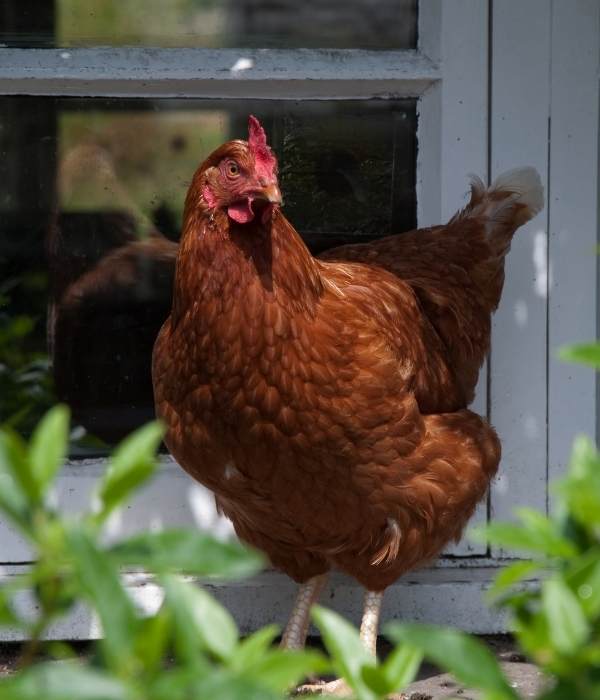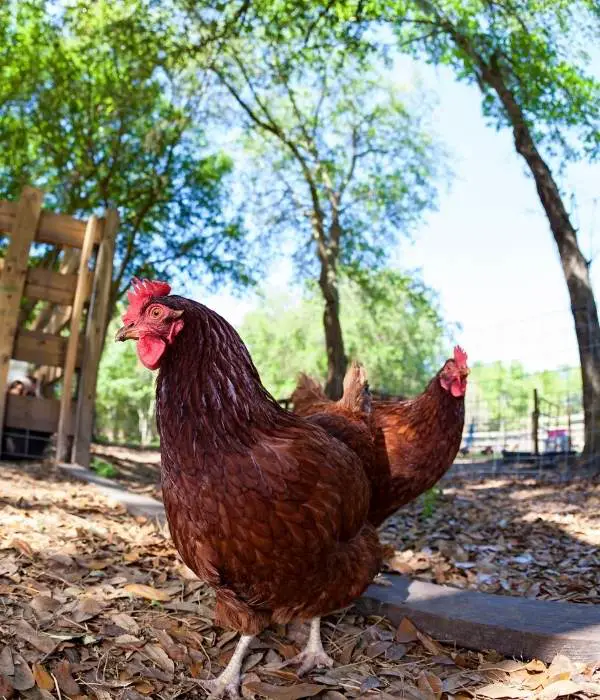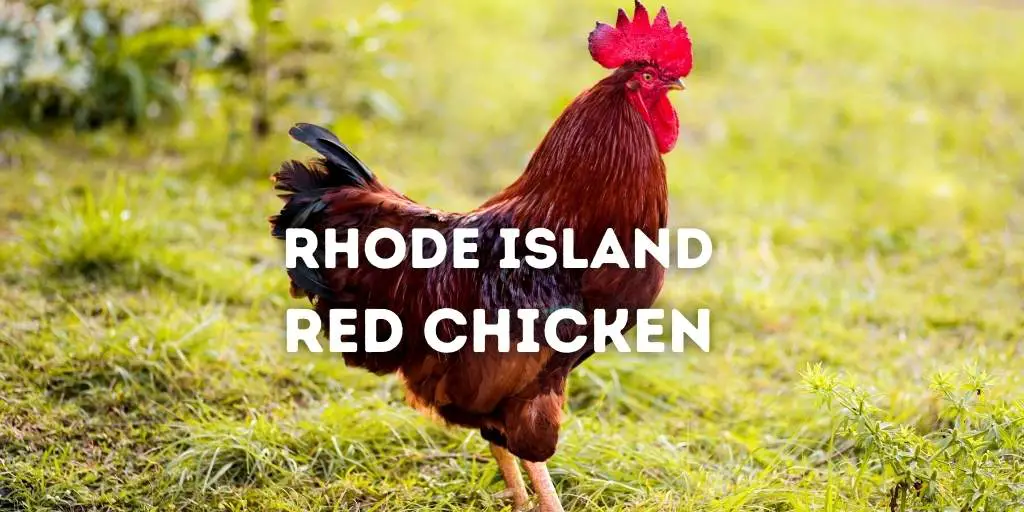Rhode Island Red (RIR) is one of the most popular chicken breeds globally. They are known for their unique nature, egg production, and meat purpose.
So, we can say RIRs are good dual-purpose chickens. This guide will help you understand the Rhode Island Reds and how to raise them in a backyard.
This breed guide includes an introduction, history, lifespan, egg production, temperament, color, size, characteristics, care guide, and more about Rhode Island Red chickens.
Introduction to Rhode Island Red Chickens (RIRs)

Rhode Island Reds (RIRs) is an amiable and helpful chicken breed. They adapt well to various weather conditions, making them available in many countries.
Moreover, they are easy to raise, and you can get many eggs and meat from them. So, this chicken is top of the list of best, friendliest chicken breeds.
RIRs are especially cold hardy chickens, but they can easily survive in warm to hot climate areas.
History of Rhode Island Red (RIR) chickens
The Rhode Island Red was first seen in 1854 Rhode Island and Massachusetts.
A sea captain, William Tripp, bought a few popular chicken breeds like Cochin, Java, Malay, and Shanghai with Italian Brown Leghorn chicken.
After continuous cross-breeding, they developed the Rhode Island Red, which was best for eggs and meat.
The first monument of Rhode Island Red was raised in 1925. Thereafter, the chicken breed was called Reds.
It became popular in 1954 when the State of Rhode Island celebrated the 100th anniversary of this chicken breed in their state.
Occasionally, William Tripp farm raised a monument of Rhode Island Red chicken in Adamsville of Little Compton, Rhode Island.
The Rhode Island Red Club of America placed the monuments. Rhode Island Reds are also the state bird of Rhode Island.
Color Varieties of Rhode Island Reds

The name of RIRs is mainly derived from their feathers. Rhode Island Reds are available in only light rusted to a dark maroon or black.
The American Poultry Association accepts both bantam and large fowl or RIR chickens. However, the chicken varieties are divided according to the appearance of the Rose and Single comb.
Lifespan of RIRs
Rhode Island Reds have a lifespan of 5-8 years. RIRs are a popular chicken breed but have a shorter lifespan than other chicken breeds like Silkie, Plymouth Rocks, Orpingtons, Wyandotte, Australorp, Cochin, and Easter Eggers.
Egg Production
Rhode Island Reds are one of the best dual-purpose chickens, so that you will get many eggs from them.
The hens of this breed lay around 180-250 light brown-colored eggs per year. So, you will quickly get 4-6 large-size eggs per week.
Some RIRs may lay around 150-200 eggs yearly because of some heritage strains.
So, most of the time, the number of eggs in this breed depends upon the genes of other breeds, which are inherited.
Also read: List of Chickens That Lay Colored Eggs
The Temperament of Rhode Island Red Chickens

Rhode Island Red chickens are friendly, docile, and calm in nature. A newbie chicken farmer can easily handle them.
You may see some aggressiveness in RIRs roosters, but occasionally. Both the girls and boys of this chicken breed are talkative.
They do well in confinement and love to free-range, but if you have a big enough backyard, let them roam. Free-ranging is far better than portable chicken coops because it keeps flocks healthy and stress-free.
Color, Size, Appearance, Characteristics of Rhode Island Red Chickens
Color
Rhode Island Red chickens look great. They mostly walk like a king. The feather of RIRs body color is rusty brown, and the tail part is black in color.
You may see some black to brownish-red feathers in some strains. RIR baby chicks are light brownish-red to tan in color.
Size
As APA accepts Rhode Island Reds, they have a standard weight. The large-size RIR roosters weigh around 8.5 lbs, and the hens around 6.5 lbs.
Appearance

The Rhode Island Red chickens are beautiful. Both the hen and roosters of this chicken breed are sturdy in look.
The hen and rooster have a U-shaped body structure, and the tail is bent upward with a 45°angle.
The earlobes and wattles are vivid red in color. You can see Rhode Island Red chickens in both single and rose comb.
The comb is red in color and easily seen with 7-9 pointed spikes. You may see faded comb in a few old-age RIR chickens.
RIRs’ skin color is yellow, and the legs are also yellow. They have four toes, and the legs have no feathers.
Characteristics
Rhode Island Reds are cold, hardy chickens that can quickly adapt to hot climate areas. You will love this chicken breed if you are a first-time chicken owner.
RIR hens are very calm and docile in nature, while the roosters of this breed are pretty aggressive.
I have one Rhode Island Red rooster who sometimes goes and fights with my neighbor’s rooster.
But usually, roosters are not aggressive with other roosters and hens in your backyard. They take care of their hers and protect them from predators.
Hens of this breed rarely go broody, so you can use a good incubator for hatching eggs if you want to get chicks.
If you have 1-2 hens, they may go broody, but broodiness is very rare in large numbers of flocks. Most of the RIR hens, which go broody, make good mothers.
Rhode Island Red Rooster Vs. Hen
The Rhode Island Red roosters are known for their aggressiveness, because of which few chicken raisers don’t like to raise this breed. It is not always true that all RIR roosters are aggressive in nature.
My Rhode Island Reds do not run toward anyone or other chickens, part of my backyard flocks. They only peck on chicken that came from our neighbor’s house.
On the other side, Rhode Island Red hens are so calm and friendly always. They do not even run or fight with neighbor ladies. However, they rarely go broody, but if they sit and hatch their eggs, they protect their kids like a pro.
Benefits of Raising Rhode Island Reds

Here are a few fantastic advantages of raising Rhode Island Red chickens –
- Rhode Island Reds love to forage in both cold and hot climates. This nature makes this breed a great advantage because of which it is famous all over the world.
- RIRs are dual-purpose chickens so that you will benefit from eggs and meat. It is a good chicken breed for backyard farmers for commercial purposes.
- If you are searching for an excellent friendly chicken for your backyard coop, this is one of the best choices.
- They rarely go broody, so collecting eggs is an easy process in RIRs. Add some good nesting boxes inside the coop and watch how they fill them with brown eggs.
- Few chicken breeds require special care for survival, but Rhode Island Reds are easy to raise and don’t need any extra care.
- Rhode Island Reds always love to forage near their owners. You will love to see their activities in your backyard area.
- Rhode Island Red chickens are great at getting rid of pests in the backyard.
- RIRs are beautiful and king-like chickens. You can also take them to exhibitions.
Care Guide of Rhode Island Red Chickens
Here are some essential tips for raising Rhode Island Reds in your backyard-
- RIRs are docile and friendly, so predators quickly attack them. Generally, this happens with Rhode Island Red hens. Add a strong chicken wire fence around your yard so they can live safely.
- If you live in a high predator attack zone, you can use one of the best electric fences.
- Most Rhode Island Red hens rarely go broody, so raising them for breed purposes requires an incubator to hatch eggs to get chicks.
- RIR chickens are giant, so you need extra space in your chicken coop. One adult fowl needs around 3-4 sq. ft. area inside the coop and 15-20 sq. ft. in the kennel run area.
- The Rhode Island Red chickens lay around the year so that you will get many large eggs from them. Please provide them with a few good nesting boxes so that they will lay their eggs comfortably.
- They are strong, resilient birds with a good immune system. If you provide them with good quality feed and vitamin supplements, you will not see any health issues or deformities in their body.
- If they go broody, Hens of this breed take care of their baby chicks very nicely.
Common FAQs
How long do Rhode Island Red chickens live?
The Rhode Island Red chickens live around 5-8 years. The life expectancy of this chicken breed is less than other breeds because of its egg-laying capacity.
How long do Rhode Island Red chickens lay eggs?
You can expect Rhode Island Red hens to lay consistently for 3-4 years, with a gradual decrease in the number of eggs. They usually lay eggs their entire life, which is negligible in the count.
How many eggs do Rhode Island Red chickens lay?
The Rhode Island Red chickens are excellent egg layers. The hens of this breed can lay up to 260-280 eggs per year.
Can Rhode Island Red chickens fly?
All chicken breeds fly to a specific height. Small chicken breeds are mostly flighty. Rhode Island Red chickens are heavy birds, so they rarely attempt to jump over heightened fences and try to fly.
How much do Rhode Island Red chicks cost?
Generally, the Rhode Island Red costs around $3 for males and $5 for female baby chicks.
Summary
Rhode Island Reds are one of the most friendly chicken breeds. They are also on the list of chickens that can be used for eggs and meat.
They have several fantastic advantages, such as a year-round ability to lay eggs and a tolerance for all climates.
Furthermore, RIRs are very docile chickens, so anyone who wants to start raising chickens of this breed can be a suitable option. If you are looking for a chicken breed with many benefits, this is one of the best.
Compared to other chicken breeds, they have good health and are not prone to diseases. I hope you enjoyed this informative article on Rhode Island Red chickens, which helped you decide whether this breed is for you.



How can I obtain these in Uganda,East Africa
Hi great information
I would like to know about this breed and also blackaurstra breed and if I want to start Farm from were will I get pure breed if any breeding Farm are there can you please share details and contact person name and no
Thanks and regards
Sanjay shringarpure
Thank you
Sir , I want approx 500 hen , but I am not able search pure rir .I also want to attend or work in a workshop .so plz guide me
You will get original breed in most of the major cities, in your countries.
Sir, I want to need (2000 )two thousand RIR chicks
Hello, I wanted to add this to our reference list, however, iti does not have the author’s name in it. Would it be possible to know who authored this? Thank you so much.
Thanks for writing here. You can put Bijaya Kumar (B. Pharma) and a link back to this page